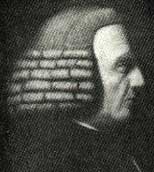
William Cookworthy m. Sarah Berry (? – 1745)
Lloyd was the 4th great grand nephew of Sarah Berry (and several other more distant relationships)
source: wikipedia
William Cookworthy (12 April 1705 – 17 October 1780) was an English Quaker minister, a successful pharmacist and an innovator in several fields of technology.
Parents, birth, siblings and early life
He was born of Quaker parents in Kingsbridge, Devon on 12 April 1705. His father, also called William, was a weaver and his mother was Edith, the daughter of John and Margaret Debell of St Martin-by-Looe in east Cornwall: they had married in 1704.
William was a bright child but his education was halted when his father died on 22 October 1718 and the family’s investment in the South Sea Company failed in the autumn of 1720.
William had been offered an apprenticeship, at no cost, by the Bevan Brothers, two Quaker apothecaries, with a successful business in London. As the family had no spare money, William walked to London to take up the offer and, eventually, successfully completed the apprenticeship.
Plymouth
The Bevans set him up in business in Plymouth, where he was extremely successful. He brought his brothers Philip and Benjamin into the partnership. He bought out the Bevans’ interest in 1745.
Marriage
In 1735, he married Sarah Berry, a Quaker from Wellington in Somerset. They had five daughters:
Lydia – 1736
Sarah – 1738
Mary – 1740
Elizabeth & Susannah (twins) – 1743
Innovations
He discovered china clay in Cornwall and devised a way of making porcelain, which previously was imported from China.
Lighthouse engineering
He was also an associate of John Smeaton, who lodged at his house when he was engaged in building the third Eddystone Lighthouse (1756–1759). Cookworthy helped Smeaton with the development of hydraulic lime, which was essential to the successful building of the lighthouse[citation needed].
Dietary advice
He advised naval officers that scurvy might be prevented and treated by supplying crews with fresh fruit and vegetables, and in their absence, sauerkraut (rich in vitamin C).
Swedenborg
In 1767 Cookworthy, in conjunction with Rev Thomas Hartley, translated Emanuel Swedenborg’s theological works, The Doctrine of Life, Treatise on Influx, and Heaven and Hell, from Latin into English.
His initial reaction to Swedenborg’s works was one of disgust, but with persistence, he was convinced of their merits and was a persuasive advocate. Hartley and Cookworthy later visited Swedenborg at his lodgings in Clerkenwell shortly before Swedenborg’s death.
Porcelain factory
In 1768 he founded a works at Plymouth for the production of Plymouth Porcelain.
Friends
It is also known that prior to his departure, Captain James Cook and Captain John Jervis, together with the naturalists Dr Solander and Sir Joseph Banks, were guests of Cookworthy.
source: wikisource:
Cookworthy having seen the kaolin from Virginia (china clay), and the petunze (china stone, or growan stone), he discovered on Tregonning Hill the Cornish china clay, and soon after he noticed that a portion of the granite, or moorstone, of the same district resembled in some respects the petunze, and on exposing it to a white heat in a crucible he obtained ‘a beautiful semi-diaphanous white substance.’ This was the Breage china stone, but, containing black particles which burnt red, it was not fitted for a porcelain glaze. At Carlegges, in St. Stephen’s parish, near St. Austell, he found subsequently both the clay and the stone of the desired purity. This appears to have been between 1755 and 1758. The clay and stone found in St. Stephen’s was on the property of Lord Camelford, who assisted Cookworthy in his first efforts to make porcelain in Plymouth, the works being established at Coxside. His progress was slow, and it was not until 1768 that he obtained a patent for the exclusive use of Cornish clay and Cornish stone in the manufacture of porcelain. In the Plymouth works from fifty to sixty persons were employed. The company—Lord Camelford being one of the firm—obtained a high-class porcelain painter and enameller from Sèvres. Henry Bone [q. v.] was educated in this pottery
Cookworthy afterwards sold the patent right to Mr. R. Champion of Bristol, who founded a pottery in that city. Neither the porcelain works in Plymouth nor those in Bristol were profitable, and in 1777 the patent right was sold to a company in Staffordshire. Cookworthy brought his chemical knowledge to bear on the porcelain manufacture, and he appears to have been the first chemist who in this country obtained cobalt-blue direct from the ores. A well-known Staffordshire potter writes of Cookworthy’s discovery: ‘The greatest service ever conferred by one person on the pottery manufacture is that of making them acquainted with the nature and properties of the materials, and his introduction of “growan stone” for either body or glaze, or both when requisite.’